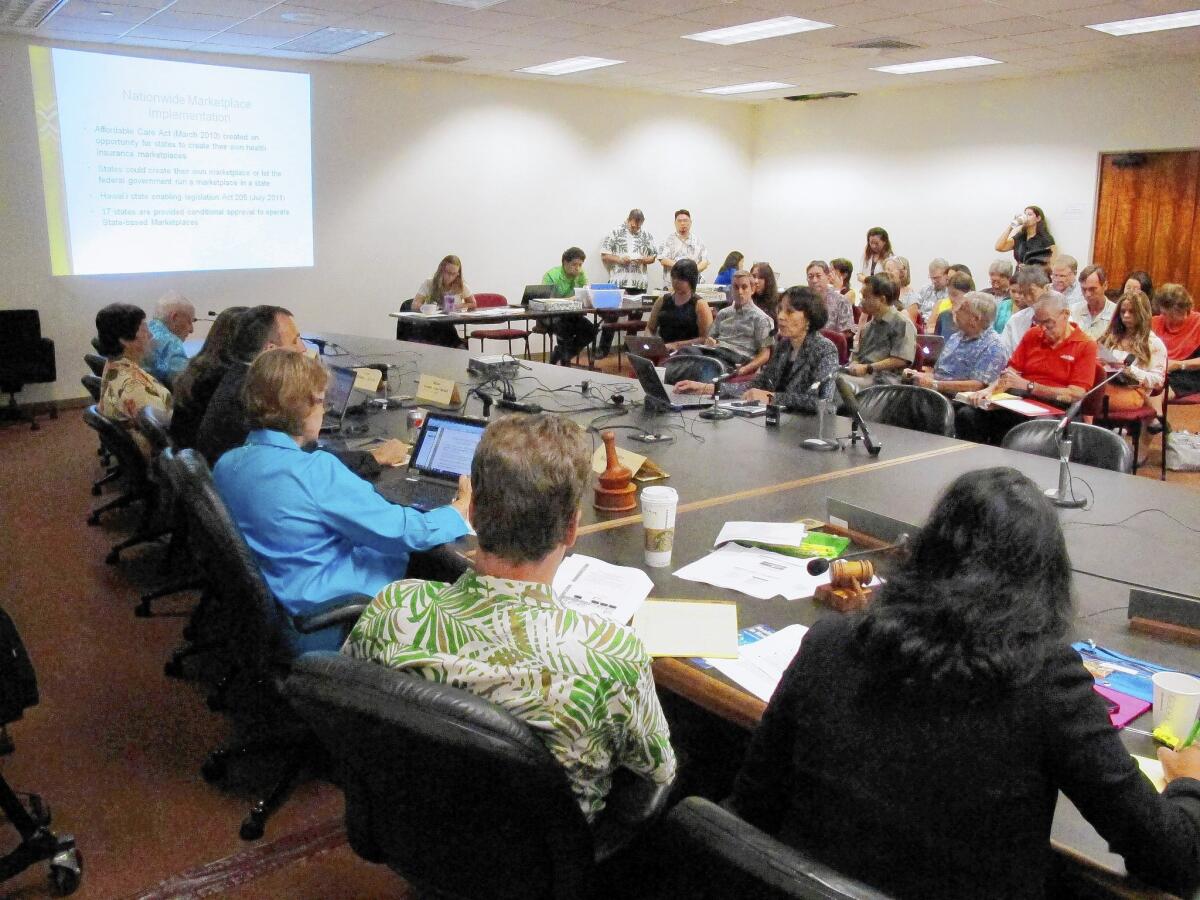Hawaii health marketplace off to an especially rough start

- Share via
HONOLULU — When the federal government began parceling out billions of dollars for the new health insurance marketplaces under the Affordable Care Act, President Obama’s home state was in an enviable position.
Hawaii already had one of the highest insured rates in the nation as the result of a 40-year-old state law requiring employers to provide coverage. The state received more than $205 million in federal money to build a health insurance exchange to serve those still uninsured.
Yet four months after enrollments began, the Hawaii Health Connector has allocated $120 million while signing up only about 4,300 people for health plans — fewer than any other state. Despite officials’ initial hopes of enrolling tens of thousands of Hawaiians, only 400 employers have applied for plans for their employees.
Colorado, by contrast, had nearly seven times as many uninsured people when it launched its health exchange with $26 million less in federal grants, and signed up more than 68,000 people by Feb. 1.
Most states operating independent health exchanges have placed them under direct state control or created strong legislative oversight, but Hawaii established its exchange as a separate nonprofit agency, rendering the details of its daily operations largely invisible to even the state Legislature. Lawmakers, who have no power to compel budget information, have struggled for months to get basic financial information or even an explanation of how the Health Connector will remain viable when federal grant money runs out this year.
The rollout has also been mired in technical problems, with the website overseen by the same company that built the federal government’s troubled HealthCare.gov website, CGI Group Inc. The original October deadline was missed by 15 days, and contractors are still trying to correct problems that have left thousands of applications caught between the agency’s system and a system built by another contractor that checks for Medicaid eligibility.
Frustration over the lack of transparency into the Health Connector’s operations has led 20 House lawmakers to sign on to a bill, scheduled for another hearing Wednesday, designed to strip it of its nonprofit status and place it under the control of the state. But that move is facing resistance from lawmakers who fear the state will be saddled with the Health Connector’s increasingly apparent financial problems and absorb its potential legal liabilities.
“Will it actually get us closer to the transparency and accountability that everybody’s screaming for?” asked Democratic state Rep. Angus L.K. McKelvey, chairman of the House Consumer Protection and Commerce Committee, which stopped short of backing a state takeover. “Making it a state agency — while on paper it may sound like we’re going to address these issues ... there are other sorts of issues that are going to emerge that could actually make it an even bigger train wreck.”
Democratic state Sen. Josh Green, an emergency room doctor and chairman of the Senate Health Committee, says he has been unable to get clear answers about the agency’s operations and viability. He said that with $205 million in grant funds, “You could have actually directly paid for people’s healthcare ... and begun to approach full care for everybody.”
Agency officials had refused until recently to disclose a budget; they said the bulk of the money had gone toward information technology contracts ($80 million), outreach ($13 million) and salaries ($6.1 million).
Those numbers are not out of line with what other states have spent, but because of the lack of details, lawmakers say they have little insight into why the money has produced such disappointing results.
For the last two months, healthcare program officials — in response to records requests from the Los Angeles Times — have declined to release anything but a nine-line summary of the current year’s budget. On Saturday they produced another summary for the 2013-14 fiscal year, which they also provided to lawmakers.
Health Connector officials refused to provide The Times with the grant applications that Hawaii submitted to the federal government to justify the state’s federal funding, saying that the release of such information would create “a potential threat” by making public ideas that could put the state exchange at a competitive disadvantage with the private sector.
The federal Centers for Medicare & Medicaid Services has also declined to discuss the Hawaii exchange. Despite requests from The Times beginning in early January, it has not released the state’s application for taxpayer dollars or its progress reports.
Hawaii Health Connector had refused even to allow the state auditor to conduct a review required under state law until the agency’s new director, Tom Matsuda, took his post at the end of last year. A federal audit, required by the Affordable Care Act, has just been completed but is not yet available because it is pending approval by the agency’s governing board.
The last publicly available audit of the nonprofit, a federal review covering July 2011 to June 2012 — the period when the newly created Hawaii Health Connector received its first major grant funds — found that it had no formal policies and procedures for how it spent its money until May 2012 and subsequently failed to follow the policies it created because employees were not familiar with them. The audit also found that the agency did not have formal procedures for handling cash.
Matsuda says that problems with the website have slowed enrollment and that he is working with contractors to address them as swiftly as possible. The agency has also recently ramped up its outreach to encourage more Hawaiians to enroll.
Since taking over from the first executive director, who quit in December without a clear explanation, Matsuda said he had struggled to make sense of the initial financial plans to keep the agency afloat, which were based on the assumption that as many as 50,000 people would enroll in 2014.
He is working on a plan to keep the agency solvent even at temporarily lower enrollment levels after the initial federal funding runs out.
“The goal ultimately is to give [lawmakers] a range of dollars, depending on the scenarios, that would be necessary for the connector to sustain itself in the next fiscal year, 2015, and the year after that, at a minimum,” Matsuda said in an interview.
He said he was relieved by the findings of the new federal audit, which is not yet available for release: “It’s a clean audit … so that’s very good for me, coming into the position, to understand that our financial management is sound and that the financial status of the organization is good.”
The changing federal rules and regulations for the Affordable Care Act — including Obama’s move to allow consumers to keep canceled plans and the delays in the employer mandate — have been partly responsible for Hawaii’s problems, said one lawmaker who did not want to be quoted criticizing the administration.
But in a Democratic state like Hawaii, lawmakers and state officials are quick to defend the president’s healthcare law despite its troubled rollout here. Several say that the state has a unique challenge in reaching the relatively few people who lack insurance — about 100,000 — and convincing them to sign up.
Legislators are considering a variety of changes to speed up enrollment and create greater oversight. Some want to change a puzzling rule under which the Hawaii Health Connector cannot offer incentives to health insurance brokers who help consumers buy plans on the exchange, even though the brokers are probably the most knowledgeable about the market.
House Health Committee Chairwoman Della Au Belatti, a Democrat who advanced the measure for a state takeover, says there is also growing support for changing the makeup of the agency’s governing board. Her committee voted for removing representatives from health insurance companies to address the appearance of a conflict of interest, and giving the House and Senate discretion to appoint several members. The governor now appoints all members of the board.
Those changes and others, Belatti said, would create “greater transparency and accountability, so that we know what’s going on with contracts.”
She added: “I’m confident that we’re going to be getting more information from the state auditor who has now been allowed in.”
More to Read
Sign up for Essential California
The most important California stories and recommendations in your inbox every morning.
You may occasionally receive promotional content from the Los Angeles Times.














